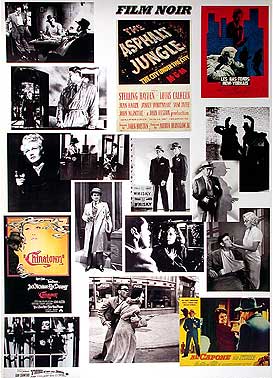Film Noir Collage
How film noir originated
Classic film noir developed during and after World War II, taking advantage of the post-war ambience of anxiety, pessimism, and suspicion. It was a style of black and white American films that first evolved during the 1940s. The name Film Noir was developed by French film critics who noticed many times how downbeat and dark the black and white films looked and themes were of many American crime (particularly murders and drugs) that were released in theatres around France following the war. Examples of film noir: Laura (1944), The Woman in the Window (1944), Murder, My Sweet (1944), The Maltese Falcon (1941).
Themes and Styles
The primary moods of classic film noir were moral corruption, evil, guilt, desperation and paranoia. Noir film's would always have heroes, villains and corrupt characters, these may be: cops, gangsters, murderers, socio-paths, a lover, femme fatales, crooks or just bad guys. These characters were morally-ambiguous low-lifes that represented and lived in the gloomy and dark underworld of violent corruption and crimes. Most film noir characters struggle in this violent underworld to survive and in the end, ultimately losing.
Storylines were often elliptical, non-linear and twisting. Narratives were frequently complex and maze-like and would almost always contain a murder, drugs, alcohol, thiefing, prostitutes or anything that is looked down on - like the characters that play in the film noir. They are typically told with background music, flashbacks, dialogue and first-person voice-over narration.


Anna could you post all your thriller research under the correct label: G321 Thriller Research. Otherwise I can miss your case studies when monitoring your blog. Could you please sort this out asap. Thanks.
ReplyDeleteI've now added all of my labels. Sorry for the delay.
ReplyDelete